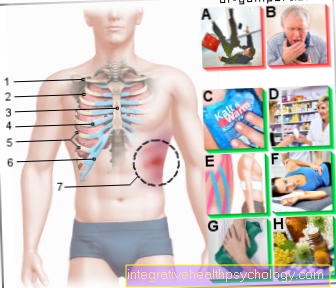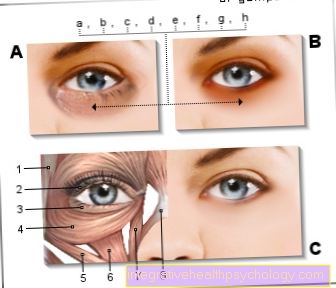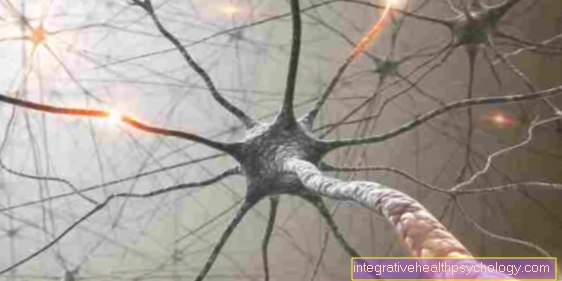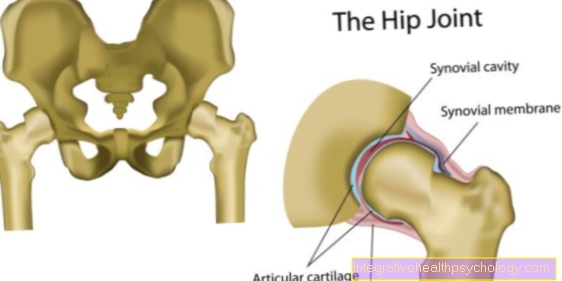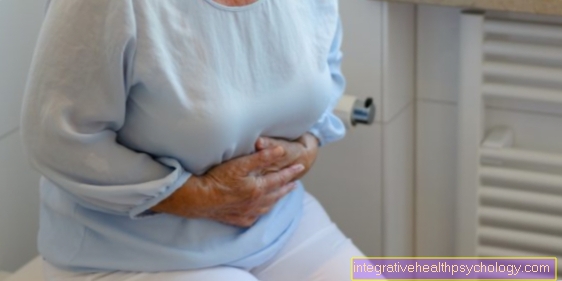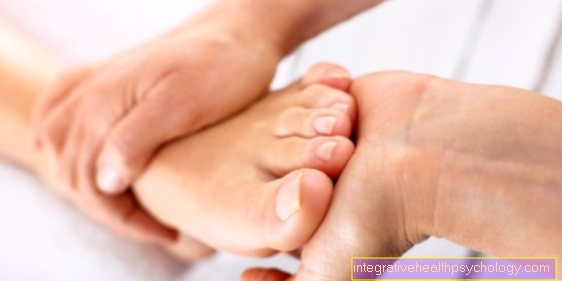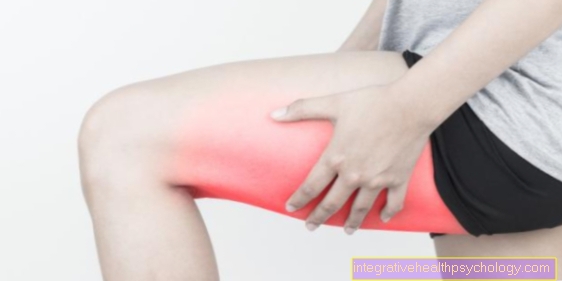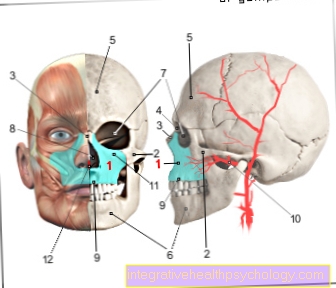Reflexes
definition
Reflexes are uncontrollable, fast and always the same reactions to certain stimuli.
Reflexes are mediated by our nervous system, consisting of nerve fibers that communicate with each other via so-called synapses. A sensor / receptor, on which the stimulus acts, is always involved in a reflex. An effector at which the reflex response takes place is also always involved. The sensor and effector are connected by the nerve fibers of our nervous system.
The spinal cord and the brain stem serve as a central switching point in which the signal-receiving nerve fibers are switched over to the nerve fibers that trigger the response.
The presence or absence of a reflex and the intensity of the reflex response can enable important conclusions to be drawn about diseases of the nervous system during the medical and neurological examination.

Reflex arc
The basis of all reflexes are the so-called reflex arcs. These are interconnections of different nerve tracts with each other, which always run over the spinal cord. In principle, these are always structured as follows: An external stimulus is perceived via a sensor (e.g. muscle spindle). This forwards the information to the spinal cord. A connection to another nerve fiber takes place here.
This in turn forwards the information to an effector (e.g. muscle), which, as the last station in the cycle, then carries out the corresponding action in response to the stimulus (e.g.Stretching of the leg) These reflex arcs can be designed with different levels of complexity. The muscle reflexes, such as the patellar tendon reflex, are kept quite simple: the sensor and effector sit in the same place and it is conveyed directly, so to speak.
However, there are also situations in which other modulating nerve fibers are interposed, which ensure that the incoming signals are amplified or inhibited. It is also possible that the sensor and effector are located in different places in the body. Then one speaks of so-called external reflexes. What they all have in common, however, is that the information does not first reach the brain and therefore does not require an arbitrary decision about the action, but that it takes place "automatically" due to the direct connection in the spinal cord.
Task of the reflexes
Reflexes are reactions of the body to external stimuli that occur immediately and do not require separate control or readiness. This can be done so quickly because the reflexes are based on a simple circuit, which directly cause a reaction to a stimulus.
The strength and duration of the applied stimulus also play a role. So there is a stimulus-reflex relationship. Reflexes serve to protect the body; for example, early childhood reflexes make it easier for the infant to find and eat food.
Reflexes play an important role in averting danger. Before a foreign body can get into the eye, for example, the blink reflex reacts and the eye is closed.
When stepping into a pointed or sharp object, the affected foot is reflexively raised and the other foot is loaded.
Some reflexes are therefore also referred to as protective reflexes. Reflexes also serve to correctly learn and execute complex movement sequences during development. The innate reflexes enable people to adapt to the circumstances and survivability, which does not have to be learned first.
You might also be interested in this topic: Pupillary reflex
What reflexes are there?
The reflexes are differentiated by the location of the receptor and effector and the number of synapses in between. If the receptor and effector are in the same organ, it is a simple reflex arc and one speaks of a self-reflex.
If the receptor and effector are in different organs, this is called an external reflex. A distinction is made between innate and learned or acquired reflexes. The reflexes are divided into visceral, somatic and mixed reflexes.
The somatic reflexes lcan be divided into reflexes with a synapse, so-called self-reflexes, and with several synaptic interconnections, so-called external reflexes.
Examples of monosynaptic reflexes are the patellar tendon or the biceps tendon reflex. An example of a polysynaptic external reflex is the reflex withdrawal reflex of the leg when stepping on a pointed object.
Visceral reflexes control the function of the internal organs to certain conditions. For example, the emptying of the bladder is controlled by visceral reflexes, the increasing filling of the bladder being the triggering stimulus in this case.
Mixed reflexes are mixtures of visceral and somatic reflexes. An example here is the action of a warm object such as a hot water bottle on the skin of the abdomen, which has a relaxing effect on tense, irritated intestines.
Reflexes in babies
Newborn children and infants have a multitude of reflexes that differ from those of an adult due to their different situation in life. Infants move almost exclusively reflexively. This is helpful because they do not yet have the motor skills to, for example, keep their balance. These reflexes serve, among other things, self-protection or nutrition. Most of these reflexes regress over time and are seen in adults as a sign of a (mostly) neurological disease.
Read more on the topic: Reflexes of a baby
The early childhood reflexes are innate, but disappear in the course of development after the first months of life.
The aim of these reflexes is to protect the infant from injury and danger, or to make it easier to find and eat food.
- Sucking reflex: lets babies up to the 3rd month automatically suck on everything that touches their lips. Used to facilitate breastfeeding
- Search reflex: with the search reflex, the baby turns its head to the touched side after touching the corner of the mouth. The sucking-swallowing reflex supports nutrition
- Grasping reflex on hands and feet. When touching this, the baby automatically grabs it. The grasping reflexes are pronounced for different lengths of time on the hand and foot: the former persists until about the 4th month, the latter until the fifteenth
- Moro or clasping reflex: With this reflex, children who are unexpectedly placed on their back should stretch their arms and fingers and then bring them back to the body and clench their fists. This should expire by the age of 6 months at the latest
- Swimming reflex: with the swimming reflex, the baby makes swimming-like movements in the water when lying horizontally
- Babinskireflex: In the Babinski reflex, the infant stretches the big toe when wiping the outer sole of the foot and makes a counter-rotating movement with the remaining toes. This infantile reflex is often tested in adults in order to gain knowledge about diseases of the nervous system.
- Galant reflex (hollow back when touching the back)
- tonic neck reflexes (stretching or bending of the extremities with neck movement)
These reflexes are regularly examined as part of the pediatric medical check-up. The individual reflexes should have regressed to certain points in their development. If, for example, the Babinski reflex occurs at a later point in time, this can be a sign of a disease of the central nervous system. Then one speaks of a pathological reflex, since this reflex response does not occur in healthy people.
You might also be interested in: Preventive examinations of the newborn
What reflexes are there on the leg?
Four reflexes are also usually tested on the leg.
- Patellar tendon reflex: the examiner taps the tendon with slightly erect legs, which can be reached a little below the kneecap. This stretches the leg in the knee joint.
- Adductor reflex: is triggered by tapping the inside of the leg just above the knee. This leads to the closing of the legs.
- Tibialis- posterior reflex: to trigger the reflex, a tendon is tapped slightly above the medial ankle, which causes the foot to rotate inwards.
- Achilles tendon reflex: here the foot is slightly stretched and hit on the Achilles tendon at the lower rear end of the lower leg or on the ball of the foot. This causes the foot to fold downwards.
Patellar tendon reflex
The patellar tendon reflex, which is also abbreviated to PSR, is a monosynaptic muscle reflex, which means that the reflex arc runs over only one synapse that connects the two nerve cells, also known as neurons. It is triggered by a blow on the tendon of the quadriceps femoris muscle, the four-headed extensor muscle of the thigh muscles, and thus leads to a contraction of the quadriceps femoris muscle and therefore to an extension of the knee joint.
The receptor and effector organs of the patellar tendon reflex are therefore identical. The patellar tendon reflex is mediated by the femoral nerve. The sensitive neurons (Afferents) transmit the stimulus to the spinal cord segment L2-L4, where the stimulus is transmitted to the motor nerve fibers (Efferents) and runs back in the femoral nerve to the muscle fiber, where a contraction is triggered. The reflex can be triggered and examined by the doctor with a reflex hammer as part of a neurological examination. If the desired reflex response does not occur, this can indicate damage to the spinal cord segment L2-4, for example in the form of a herniated disc or an injury to the femoral nerve, and should be further clarified.
Read more on the topic: Patellar tendon reflex
What reflexes are there on the arm?
Different reflexes can be triggered on the arm. The starting position is the patient lying on his back, who puts his arms loosely on the groin. The following four are usually tested:
- Biceps tendon reflex: with the biceps tendon reflex, a finger of the examiner is placed on the biceps tendon in the crook of the elbow and then struck. This causes the forearm to bend.
- Brachioradialis / Radiuspersiostreflex: The brachioradialis reflex is triggered by tapping the inner forearm near the wrists. This results in a slight flexion of the forearm.
- Triceps tendon reflex: for the triceps tendon reflex, the examiner strikes the said tendon on the outer elbow, which extends the forearm.
- Trömner reflex: the Trömner reflex is triggered when the hand is relaxed and hanging. The examination snaps against the fingertips from the front. Here the hand closes slightly.
What reflexes does the hair have?
The hair is also subject to reflexes. Everyone knows the phenomenon of so-called "goose bumps". This is ultimately a reflex which leads to the straightening of the hair. The whole thing is evolutionary: our ancestors were much hairier than us. In the cold or in danger, the hair cells straightened up due to reflexes, so that the fur was puffed up.
On the one hand, this resulted in the inclusion of air and an associated layer of insulation against the cold and, on the other hand, it looked significantly more threatening. This reflex has remained with us to this day, even if its function can now be neglected.
How can you test reflexes?
The examination or examination of the reflexes is part of the physical examination and the neurological examination.
This examination tests whether the reflexes can be triggered on the same side to a physiological extent and depending on the reflex, or whether pathological reflexes are present.
The ascertainment of the so-called reflex status is examined according to the reflex to be examined with the reflex hammer or other neurological aids, such as a brush, a sharp object or the hand of the examiner.
When testing one's own reflexes, a light blow is made with the reflex hammer on the tendon of a muscle (e.g. patellar tendon reflex), which causes the muscle to contract. If possible, a reflex is always examined in a side-by-side comparison in order to be able to better assess the reflex response. It is assessed whether the reflex response is “normal”, “reduced”, “increased” or “absent”.
What is a reflex hammer?
If a doctor wants to test his patient's reflexes, the method of choice is the so-called reflex hammer. This is a device which, with a practiced technique, makes it possible to tap a certain point (usually a tendon) very precisely and with the same force.
The hammer is usually made of metal, but can also be made of plastic and has ends provided with rubber. There are many different models, the most common of which is the "Trömner" hammer, which has two ends of different sizes: one for adults and one for children and is characterized by the medium-long handle and the characteristic shape of the handle.
What is reflex epilepsy?
Reflex epilepsy is a very rare disease of the brain in which certain signals or stimuli are responded to with a seizure.
These stimuli are very different, but it is often processes that place particularly high demands on the brain, i.e. complex services. Visual stimuli are often the trigger for reflex epilepsy: epileptic seizures occur when the incidence of light (e.g. stroboscope), particularly bright or flickering light, and even with very quickly changing images (e.g. action films, computer games) occur.
But other services, such as reading, arithmetic or even listening to a certain melody, can also be used as triggers. The cause of this lies in a faulty switching of certain nerve tracts, so that there is unwanted activity in the brain of the person concerned and they then react in the form of a spasm. This can manifest itself in the stiffened slump or in the knocking out of individual limbs. Patients often bite their tongues at the same time. Reflex epilepsy has a very good prognosis: often just avoiding the triggering situation is enough to prevent a new attack. In addition, you can prescribe so-called anticonvulsants, which also reduce the seizure activity.
Also read the article on the topic: Drugs for epilepsy

